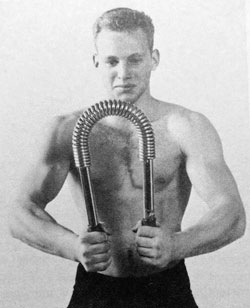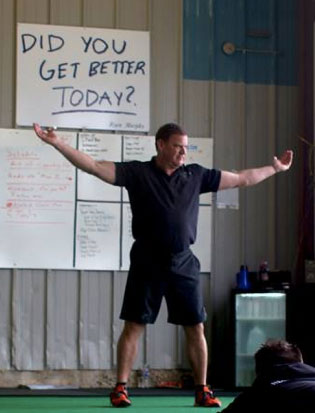The book came out in 1962 and is still pretty good. Much of the advice stands the test of time, "If you don’t want to get hurt, learn to fall." Callum’s advice on dealing with a robber with a gun is still pretty good: It is better to lose 100% of your money than take that one percent chance of losing your life.
In 1997, Ken Shamrock came out with
Inside the Lion’s Den. Based on training for the early years of submission fighting, this book deals more with fighting inside the safe confines of the fighting cage. Oh, and I mean that. In real life fighting, there are no tap outs and referees.

Callum and Shamrock share many of the same core concepts. Callum reflects the total body movements of the 1960s with squats on the toes, Jefferson lifts and side bends. Shamrock thins the barbell work to simply bench press, squats, clean and jerks and curls. But, he also demands high volumes of
bodyweight squats, tumbling work (both include cartwheels) as well as something he calls "scrambling," which includes a variety of ground based exercises and various games of movement. In the 35 years between the publications of these books, we regressed in the field of fitness, conditioning and strength work. The influence of the machines, from the Universal Gyms through Nautilus and all of the knock-offs, got people thinking in bodyparts. Then, with the rise of bodybuilding (especially after Arnold’s
The Education of a Bodybuilder) the pump, the blitz and the pythons overtook traditional training.
So, here we are today: we have coaches who specialize in corrective work to undo the problems of their training programs. That was a mean statement, but understand my point: if you are spending more time in foam rolling, rehab, hot tub, massage and other modalities than you are in actually training, something is very wrong.
Let’s just take foam rolling. Actually, I often wish someone would just take it away, but I understand what we are doing here. An alternative to foam rolling is….rolling! Shoulder rolls on a wrestling mat not only prep me for life’s slips and falls, but I also have to get the added benefit of rubbing my fascia with a lot of load. Cartwheels are part of my Loaded Carry family: this is literally a moving plank and a great way to check in on your body connections.
The Turkish get-up can be a boon for getting people to remember what it is like to get up and down off the floor. Pat Flynn regards the TGU as a Loaded Carry and I think he gets it right: it is a Loaded Carry with extra benefit of also being an exercise where you reorient yourself with the floor.
TGUs and Shamrock’s "scrambles" would be a fun and enlightening workout for anyone. The scrambles are children’s games like leap frog and jumping over sticks: these are rarely seen in most training gyms but a lot of fun to both do and coach.
Let me add just one extra thing: Phil Maffetone remarked that 28,000 Americans die from falls and fall related injuries every year in my age range. God forbid you bring peanut butter to a school, but NOTHING is being done seriously about falling. Let me make a small point: recently, the BBC had a show about risks. Eating bacon every day for breakfast might affect your chances of survival the next ten years. How much? The show noted that daily bacon consumption will move you from five in a 1000 chance of death to SIX.

The most dangerous thing you do? Take a shower. Now, some of the readership is safe here, but I usually take two a day…trust me, I need to take two. So, day in and day out, my life teeters on entering and exiting my shower. It’s the riskiest thing I do as I don’t have a commute to work.
Those years of fall training that I learned in Judo probably lower my risks. I know how to fall and break a fall. Do your parents? Do you?
As nice as it is to have six pack abs, it is also nice to be alive at your grandkid’s wedding. So, barf less at your next workout and practice falling. And, like me, be aware of stepping in and out of the shower.
When the running/jogging craze emerged in the late 1960s and 1970s, Cooper came out with the term "aerobics." Along with all the junk mileage came injuries to runners. The answer was stretching. Static stretching, dynamic stretching, dynamic mobility, and PNF were all touted as the answers to various shin, knee, foot and hip injuries. Barefoot running has been called the answer lately, too. But there used to be a better approach: stretching in conjunction with proper training.
Both Callum and Shamrock discuss flexibility and mobility, but in the classic sense that these are synergistic with the rest of training. Some movements simply stretch you out, like goblet squats, swings, and windmills that are my "go to" movements for blending strength with mobility. You can easily argue for many more. Many movements in the bodyweight world demand flexibility and I have noticed great changes since following the simple advice in the book,
Rings of Power.
Being flexible is important, but being flexible and strong is more important.
For aerobic work or "cardio" (and lo how I loathe those terms) doing garbage mileage on the track, the treadmill, the rowing machine and the bicycle certainly have great value. It prepares you for garbage mileage. Shamrock demands 500 bodyweight squats BEFORE he lets you condition with him! Training to fight is not the same as spinning your wheels…literally.